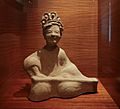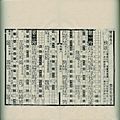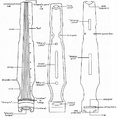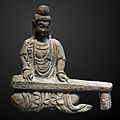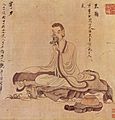Guqin facts for kids
The Guqin (pronounced "goo-chin") is an ancient Chinese musical instrument. It has seven strings and belongs to the zither family. People have played the Guqin for thousands of years. It was especially loved by educated people in China for its beautiful and gentle sound.
The word "Guqin" means "ancient stringed instrument." In the past, it was just called "qin." But because many other instruments also started using "qin" in their names (like the piano, which is "gangqin" in Chinese), the word "gu" (meaning "ancient") was added. This helps everyone know which instrument is being talked about. Sometimes, it is also called "qixianqin," which means "seven-stringed instrument." The Guqin is different from the Guzheng, another Chinese zither, because the Guzheng has movable bridges under its strings.
The Guqin is a very quiet instrument. It can play notes over about four octaves. Its lowest notes are very deep, like a cello. Players make sounds by plucking open strings, pressing down on strings, or creating special "harmonic" sounds. When a player presses a string, they can slide their finger. This makes a smooth, gliding sound, a bit like a cello or a fretless bass guitar. Guqin music often has many harmonic sounds. This is possible because the instrument has 91 special spots for harmonics.
Contents
History of the Guqin
People say the Guqin is about 5,000 years old. Legends tell us that famous ancient Chinese leaders like Fuxi and Shennong helped create it. Writings from nearly 3,000 years ago mention the Guqin. Instruments similar to the Guqin have been found in tombs from about 2,500 years ago. Chinese tradition says the Guqin first had five strings. Two more strings were added around 1,000 BCE, making it seven strings.
The Guqin we know today likely took its shape around the late Han Dynasty (206 BC - 220 AD). This is based on old writings. The oldest Guqins that still exist today are from the Tang Dynasty (618-907). Many of these old instruments can still be played. One very famous old Guqin is called "Jiuxiao Huanpei." It was made by a famous craftsman named Lei Wei. This instrument is now kept in the Forbidden City Museum in Beijing.
In 1977, a recording of a Guqin song called "Liu Shui" (Flowing Water) was sent into outer space. NASA put it on the Voyager Golden Record. This record contains music from all over the world. It was sent on the Voyager 1 and Voyager 2 spacecrafts. "Liu Shui" is the longest music track on the record. In 2003, UNESCO recognized Guqin music as a "Masterpiece of the Oral and Intangible Heritage of Humanity." This means it is a very important part of human culture.
Guqin Schools and Players
Over many centuries, different styles of Guqin playing developed in China. These styles are called "qin pai" or "Guqin schools." They usually formed in areas where many people played the Guqin.
Some of the main Guqin schools include:
- Guangling
- Yushan
- Shu
- Fanchuan
- Songjiang
- Jinling
- Zhucheng
- Mei'an
- Min
- Pucheng
- Jiuyi
- Zhe
- Shaoxing
- Wu
- Shan'nan
Most Guqin schools are in China. But in the 20th century, some groups started in other countries. For example, the Tokyo Qin Society was recently started in Japan.
How to Play the Guqin
The beauty of Guqin music comes from how players change each note. There are three main types of sounds on the Guqin:
- San yin (scattered sounds): This is when you simply pluck an open string.
- Fan yin (floating sounds): These are harmonics. The player lightly touches the string at special spots (marked by white dots) and then plucks. This makes a clear, ringing sound.
- An yin (stopped sounds): This is the most common type of sound. The player presses a string down onto the board and then plucks. They can then slide their finger up and down to change the pitch.
Players usually grow their fingernails a little long for playing. The length depends on what the player likes, but it's often about 3-4mm past the fingertip. If the nail is too short, the fingertip might touch the string and stop the sound. If it's too long, it can make playing difficult. Usually, the nails on the right hand are kept long for plucking. The nails on the left hand are kept short for pressing on the strings.
Right Hand Techniques
There are eight main ways to pluck the strings with the right hand:
- Pi 〈劈〉: Thumb plucks outwards.
- Tuo 〈托〉: Thumb plucks inwards.
- Mo 〈抹〉: Index finger plucks inwards.
- Tiao 〈挑〉: Index finger plucks outwards.
- Gou 〈勾〉: Middle finger plucks inwards.
- Ti 〈剔〉: Middle finger plucks outwards.
- Da 〈打〉: Ring finger plucks inwards.
- Zhai 〈摘〉: Ring finger plucks outwards.
The little finger is not used. These basic moves can be combined to make many more techniques. For example, Cuo 〈撮〉 is plucking two strings at the same time. Lun 〈輪〉 is plucking a string quickly with the ring, middle, and index fingers.
Left Hand Techniques
Left hand techniques include pressing down on the string and sliding up or down to new notes. Players also use vibrato, which is swaying the hand to make the sound waver. There are over 15 different types of vibrato! Other techniques include plucking a string with the thumb while another finger stops the string.
Both Hands Together
Some techniques use both hands at the same time and are harder to do. For example, qia cuo san sheng 〈掐撮三聲〉 combines hammering on and off strings with plucking two strings. Another exciting technique involves pressing all seven strings with the left hand. Then, the right hand strums them all. The left hand quickly slides up the Guqin, making a sound like water splashing.
To play the Guqin well, a player needs to learn over 50 different techniques. Even common ones like "tiao" are hard to do right without a teacher.
Guqin Music and Notation
Guqin music is written in a special way called tablature. It doesn't tell you exactly what notes to play like modern music. Instead, it shows you how to play each note. It describes the tuning, where to put your fingers, and how to pluck the strings. Some tablatures also show notes using the "gongche" system or use dots for rhythm.
The oldest example of this special shorthand tablature is from around the 12th century CE. An even older form of music notation from the Tang era (7th century CE) is found in one manuscript called "Jieshi Diao: You Lan" (Solitary Orchid). This older form used full Chinese characters to describe every detail. Later, during the Tang dynasty, a person named Cao Rou simplified this notation. He used only the important parts of the characters. This made it much faster to write down Guqin music. This new way was called "jianzi pu" (reduced notation).
This new notation was very successful. From the Ming dynasty (1368-1644) onwards, many collections of Guqin tablature, called "qinpu," appeared. One of the most famous is "Shenqi Mipu" (The Mysterious and Marvellous Tablature). In the 1960s, a researcher named Zha Fuxi found over 130 qinpu collections. These contained more than 3,360 pieces of music. Many old qinpu are now lost, and many songs have not been played for hundreds of years.
Today, Guqin music is often printed with modern staff notation above the Guqin tablature. This helps players understand the rhythm and notes better.
Learning Guqin Songs
Guqin songs are usually 3 to 8 minutes long. The longest famous piece is "Guangling San," which is 22 minutes long. Other well-known songs include "Liu Shui" (Flowing Water) and "Meihua San Nong" (Three Variations on the Plum Blossom Theme).
Most players can play about ten songs from memory very well. They learn new songs when they want to. Players often learn popular versions of songs and listen to recordings to help them. Very skilled Guqin players can also create their own music or improvise. But they need to know the instrument extremely well to do this.
Dapu is the process of turning old tablature into music that can be played. Since Guqin tablature doesn't show note length or rhythm, the player has to figure it out. Usually, players learn the rhythm from a teacher. The student copies the teacher. The tablature is only used if the teacher is unsure about a part. Because of this, old qinpu don't show rhythm. If a player didn't have a teacher, they had to work out the rhythm themselves.
How the Guqin is Made
Traditionally, the Guqin had five strings. These strings represented the five elements: metal, wood, water, fire, and earth. Later, two more strings were added. This made it seven strings.
The Guqin has 13 round mother-of-pearl dots on its surface. These are called "hui." They mark the spots where harmonics are played and help with finger positions. The top board of the Guqin is slightly rounded, like the sky. The bottom board is flat, like the earth. The whole instrument is about 3 feet, 6.5 inches long. This length represents the 365 days of the year. Each part of the Guqin has a special name, like "dragon pool" and "phoenix pond."
The Guqin's sound chamber is made of two pieces of wood. The top board, or soundboard, is usually made from tong wood (Chinese parasol tree). The bottom board is often made of zi mu (catalpa) or nan mu (camphor wood). The wood must be very old and dry. If there is still sap or moisture, the sound won't be clear, and the wood might warp. Some makers use very old wood, even from ancient tombs! But newer Guqins made from good tong wood can sound even better than some antiques.
The Guqin has two sound holes on its bottom board. The inside of the top board is partly hollowed out. Inside the Guqin, there are "nayin" (sound absorbers) and "tian chu" and "di chu" (soundposts). These connect the top and bottom boards. The boards are joined with bamboo nails. Then, a special lacquer from the Chinese lacquer tree is put on the Guqin's surface. This lacquer is mixed with powders, often from deer antler. After many layers of lacquer dry, the surface is polished.
At one end of the instrument is the "yue shan" or bridge. At the other end is the "long yin" (dragon's gums) or nut.
Guqin Strings
For a long time, Guqin strings were always made of twisted silk. But after the Cultural Revolution, most players started using modern nylon-flatwound steel strings. This was because silk strings were hard to find. Also, the new strings were stronger and louder.
Silk strings are made by twisting many silk threads together. This cord is then soaked in natural glue to bind the threads. After drying, the strings are cut to the right length. The thicker strings are also wrapped in a thin silk thread to make them smoother.
Recently, good quality silk strings are being made again in China. More players are starting to use them. Many traditional players believe that silk strings have a more refined sound. Also, modern metal strings can sometimes damage old Guqins. The sliding sound of fingers on the strings is a special part of Guqin music. Modern metal strings have been changed a bit to help create these sliding sounds.
Tuning the Guqin
To string a Guqin, you tie a special knot at one end of the string. Then, you thread the string through holes at the head of the Guqin. It comes out the bottom through tuning pegs. The string goes over the bridge, across the board, over the nut, and then wraps around two "feet" at the back of the Guqin. After this, the strings are fine-tuned using the pegs.
The most common tuning is called "zheng diao." It uses a five-note scale. This is usually like C D F G A c d. But the Guqin was not always tuned to an exact pitch. So, what matters most are the relationships between the seven strings. Other tunings are made by changing the tightness of the strings with the tuning pegs.
Where the Guqin is Played
The Guqin is almost always played as a solo instrument. Its quiet sound means it can't be heard over most other instruments or large groups. However, it can be played with a xiao (a bamboo flute), with other Guqins, or while singing. In the past, the se (a long zither with 25 strings) was often played with the Guqin.
If another instrument plays with the Guqin, its sound must be soft. This way, it doesn't overpower the Guqin. The xiao flute used for this is usually a special "qin xiao," which is narrower than a regular xiao. If someone sings along with Guqin music, they should sing in a low, deep voice. The singing style is like reciting old Tang poetry.
Traditionally, the Guqin was played in a quiet room by oneself or with a few friends. It was also played outdoors in beautiful natural places. Today, many Guqin players perform in concerts in large halls. They usually need to use microphones to make the sound louder. Many players also attend "yaji" (elegant gatherings). At these gatherings, Guqin players and music lovers can meet to discuss and play the instrument.
Images for kids
-
A girl playing a guqin, Eastern Han dynasty, collection of the Musée des Arts Asiatiques de Toulon, France
-
The Tang dynasty (618–907) qin, the "Jiu Xiao Huan Pei"
-
A selection of different qin strings. Top to bottom: (太古琴絃) Taigu Silk Qin Strings (中清 zhongqing gauge) with a container of 'string gum' (絃膠), (上音牌琴弦) Shangyin Shanghai Conservatorie Quality Qin Strings (metal-nylon), (虎丘古琴絃) Huqiu Silk Strings
-
Rock carving of a bodhisattva playing a guqin, found in Shanxi, Northern Wei dynasty (386–534)
See also
 In Spanish: Guqin para niños
In Spanish: Guqin para niños



